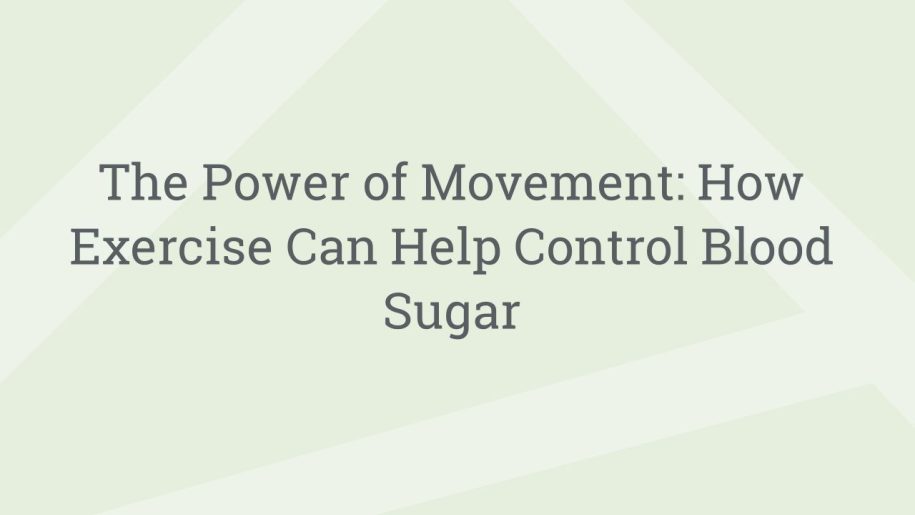The Power of Movement: How Exercise Can Help Control Blood Sugar
Table of Contents
Introduction: Why Fitness Matters More Than Ever
In today’s world, where we are dealing with stress, anxiety, and physical health issues, incorporating movement into our daily routine is more important than ever before. Exercise is an excellent way to combat stress, maintain mental and physical health, and manage illnesses. It is commonly known that regular physical activity can help with weight loss and maintaining a healthy weight. Additionally, it is critical in controlling blood sugar levels, especially for individuals suffering from type-2 diabetes. In this blog, we will outline the power of exercise and how it can help control blood sugar levels, providing insights on how to build an effective fitness plan tailored to your personal needs and preferences.
Understanding the Anatomy of a Successful Workout Routine
Creating a successful workout routine is the foundation of achieving fitness goals, whether it is weight loss, strength training, or overall wellness. A successful workout routine should have a balance of cardiovascular exercise and strength training, tailored to the individual’s needs and goals. Before starting, it is essential to understand the anatomy of a workout routine, primarily focusing on the frequency, duration, and intensity required to achieve the results. A workout routine should be planned with specific goals in mind, and it should be regularly adjusted as progress is made to avoid the training plateau.
Incorporating Cardio for Heart Health and Endurance
Cardiovascular exercise is essential for maintaining heart health, weight loss, and general endurance. It can help the body process glucose more effectively, reducing insulin resistance in individuals with type-2 diabetes. Walking, running, swimming, cycling, and dancing are excellent examples of cardio exercises. In addition to traditional cardio exercises, High-Intensity Interval Training (HIIT) can be an efficient way to incorporate cardio exercise by combining short bursts of high-intensity exercise with low-intensity recovery periods.
Building Strength with Resistance Training and Weights
Strength training and weightlifting are essential to build and maintain muscle mass, increase bone density, and reduce the risk of chronic conditions such as type-2 diabetes, heart disease, and obesity. Resistance training and weights exercises should be an essential part of your workout routine, focusing on compound exercises, such as squats or deadlifts, and isolation exercises, such as bicep curls.
Yoga and Pilates for Flexibility, Balance and Mind-Body Connection
Yoga and Pilates are ancient forms of exercise that emphasize the connection between the mind and body, improving flexibility, balance, and mental wellbeing. They both offer a low-impact way to improve muscle tone and increase strength gradually. Incorporating these into your workout routine can be incredibly beneficial, providing a balance between strength training, cardiovascular exercise, and relaxation techniques.
Nutrition: Fueling Your Body for Optimal Results
Nutrition plays a pivotal role in exercise and fitness, and a balanced diet is essential to fuel workouts effectively. Understanding macronutrients, such as proteins, fats, and carbohydrates, and micronutrients, such as vitamins and minerals, can be critical in meeting your fitness goals. Eating a balanced diet, including complex carbohydrates, lean proteins, and healthy fats, can provide the necessary energy for workouts, aid in building and maintaining muscle mass and aid in post-workout recovery.
Tips for Staying Motivated in Your Fitness Journey
Staying motivated can be challenging, establishing routines and habits that promote healthy living’s continuity can ease the burden of motivation. Creating a workout schedule, tracking progress, and finding an accountability partner can help individuals maintain and track their fitness journey. Incorporating fun and social activities into your fitness routine can also help foster a positive mind-body connection and release endorphins which can contribute to long-lasting motivation.
Making Fitness a Lifestyle: Habits and Mindset Shifts That Stick
Making fitness a lifestyle takes time and effort and requires creating habits and mindset shifts that stick. It is important to identify healthy habits and values that align with an individual’s fitness goals and lifestyle. Planning ahead, setting realistic goals, and creating a personalized fitness plan that aligns with an individual’s values can help create healthy habits that stick.
Personalizing Your Fitness Plan: Goals, Tracking and Adjustments
Personalizing your fitness plan is an essential aspect of achieving your fitness goals. Using specific, measurable, achievable, realistic, and timely (SMART) goal-setting strategies can help track progress and make necessary adjustments to the fitness plan. Individuals should regularly track their progress and adjust their plan to ensure continued progress and success.
Closing Thoughts: Investing in Yourself for a Healthier, Happier Life
Investing in oneself through fitness is one of the most essential gifts we can give ourselves. Regular exercise improves overall health and wellbeing, reduces our risk of disease, contributes to longevity, and boosts self-confidence. By creating a personalized fitness plan that aligns with an individual’s goals, values, and lifestyle, individuals can invest in themselves and achieve long-lasting success.
Conclusion
Physical activity offers a myriad of benefits, including controlling blood sugar levels, managing chronic illnesses, weight loss, and improved physical and mental wellbeing. By building a personalized workout routine and mindset that fosters healthy habits, individuals can achieve success in their fitness journey. By taking control of their health through exercise and nutrition, individuals can invest in their long-term health and happiness, helping them lead fulfilling and satisfying lives.
